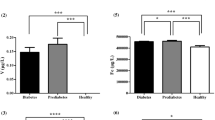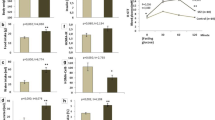Abstract
Homeostasis of trace elements can be disrupted by diabetes mellitus. On the other hand, disturbance in trace element status in diabetes mellitus may contribute to the insulin resistance and development of diabetic complications. The aim of present study was to compare the concentration of essential trace elements, zinc, copper, iron, and chromium in serum of patients who have type 2 diabetes mellitus (n = 20) with those of nondiabetic control subjects (n = 20). The serum concentrations of zinc, copper, iron, and chromium were measured by means of an atomic absorption spectrophotometer (Shimadzu AA 670, Kyoto, Japan) after acid digestion. The results of this study showed that the mean values of zinc, copper, and chromium were significantly lower in the serum of patients with diabetes as compared to the control subjects (P < 0.05). Our results show that deficiency of some essential trace elements may play a role in the development of diabetes mellitus.
Similar content being viewed by others
References
Friederich M, Hansell P, Palm F (2009) Diabetes, oxidative stress, nitric oxide and mitochondria function. Curr Diabetes Rev 5:120–144
Cheng Z, Tseng Y, White MF (2010) Insulin signaling meets mitochondria in metabolism. Trends Endocrinol Metab 21:589–598
Larsen GL, Henson PM (1983) Mediators of inflammation. Annu Rev Immunol 1:335–359
Viktorínová A, Toserová E, Krizko M, Duracková Z (2009) Altered metabolism of copper, zinc, and magnesium is associated with increased levels of glycated hemoglobin in patients with diabetes mellitus. Metabolism 58:1477–1482
Kinlaw W, Levine A, Morley J (1983) Abnormal zinc metabolism in type II diabetes mellitus. Am J Med 75:273–277
Niewohner C, Allen J, Boosalis M (1986) Role of zinc supplementation in type II diabetes mellitus. Am J Med 81:63–68
Pickup JC, Crook MA (1998) Is type II diabetes mellitus a disease of the innate immune system? Diabetologia 41:1241–1248
Anderson R, Roussel AM, Zouari N (2001) Potential antioxidant effects of zinc and chromium supplementation in people with type 2 diabetes mellitus. J Am Coll Nutr 20:212–218
Anderson RA, Cheng N, Bryden NA, Polansky MM, Cheng N, Chi J, Feng J (1997) Elevated intakes of supplemental chromium improves glucose and insulin variables in individuals with type 2 diabetes. Diabetes 46:1786–1791
Kazi TG, Afridi HI, Kazi N, Jamali MK, Arain MB, Jalbani N, Kandhro GA (2008) Copper, chromium, manganese, iron, nickel, and zinc levels in biological samples of diabetes mellitus patients. Biol Trace Elem Res 122:1–18
Pickup JC, Matttock MB, Chusney GD, Burt D (1997) NIDDM as a disease of the innate immune system: association of acute phase reactants and interleukin-6 with metabolic syndrome X. Diabetologia 40:1286–1292
King GL (2008) The role of inflammatory cytokines in diabetes and its complications. J Periodontol 79:1527–1534
Barham D, Trinder P (1972) An improved colour reagent for the determination of blood glucose by the oxidase system. Analyst 97(151):142–145
Zhao C, Wang H, Zhang J, Feng L (2008) Correlations of trace elements, glucose and body compositions in type 2 diabetics. Wei Sheng Yan Jiu 37:600–605
Al-Maroof RA, Al-Sharbatti SS (2006) Serum zinc levels in diabetic patients and effect of zinc supplementation on glycemic control of type 2 diabetics. Saudi Med J 27:344–350
Ekin S, Mert N, Gunduz H, Meral I (2003) Serum sialic acid levels and selected mineral status in patients with type 2 diabetes mellitus. Biol Trace Elem Res 94:193–201
Abou-Seif MA, Youssef A (2004) Evaluation of some biochemical changes in diabetic patients. Clinica Chimica Acta 346:161–170
Zheng Y, Li XK, Wang Y, Cai L (2008) The role of zinc, copper and iron in the pathogenesis of diabetes and diabetic complications. Therapeutic effects by chelators Hemoglobin 32:135–145
Pieper GM, Jordan M, Donglinger LA, Adams MB, Roza AM (1995) Peroxidative stress in diabetic blood vessels. Diabetes 44:884–889
Duman BS, Ozturk M, Yilmazer S, Hatemi H (2003) Thiols, malonaldehyde and total antioxidant status in the Turkish patients with type 2 diabetes mellitus. Tohoku J Exp Med 201:147–155
Cunningham JJ (1998) Micronutrients as nutriceutical interventions in diabetes mellitus. J Am Coll Nutr 17:7–10
Fernando GR, Martha RM (2005) Complementary therapies for diabetes; the case for chromium, magnesium and antioxidants. Arch Med Res 36:250–257
Heyland DK, Dhaliwal R, Suchner U, Berger MM (2005) Antioxidant nutrients: a systematic review of trace elements and vitamins in the critically ill patient. Intensive Care Med 31:327–337
Campbell AP (2010) Diabetes and dietary supplements. Clin Diabetes 28:35–39
Ekmekcioglu C, Prohaska C, Pomazal K, Steffan I, Schernthaner G, Marktl W (2001) Concentrations of seven trace elements in different hematological matrices in patients with type 2 diabetes as compared to healthy controls. Biol Trace Elem Res 79:205–219
Chehade JM, Sheikh-Ali M, Mooradian AD (2009) The role of micronutrients in managing diabetes. Diabetes Spectr 22:214–219
Chinyere NA, Usoro CAO, Etukudo MH, Usoro IN (2005) Serum and urine levels of chromium and magnesium in type 2 diabetics in Calabar, Nigeria. Mal J Nutr 11:133–142
Nsonwu AC, Usoro CAO, Etukudo MH, Usoro IN (2006) Influence of age, gender and duration of diabetes on serum and urine levels of zinc, magnesium, selenium and chromium in type 2 diabetics in Calabar, Nigeria. Turk J Biochem 31:107–114
Salas-Salvadó J, lez Martinez-Gonzá MA, Bullo M, Ros E (2011) The role of diet in the prevention of type 2 diabetes. Nutr Metab Cardiovas 21:B32–B48
Fowler JM (2007) Diabetes treatment, part 1: diet and exercise. Clin Diabetes 25:105–109
Author information
Authors and Affiliations
Corresponding author
Rights and permissions
About this article
Cite this article
Basaki, M., Saeb, M., Nazifi, S. et al. Zinc, Copper, Iron, and Chromium Concentrations in Young Patients with Type 2 Diabetes Mellitus. Biol Trace Elem Res 148, 161–164 (2012). https://doi.org/10.1007/s12011-012-9360-6
Received:
Accepted:
Published:
Issue Date:
DOI: https://doi.org/10.1007/s12011-012-9360-6




